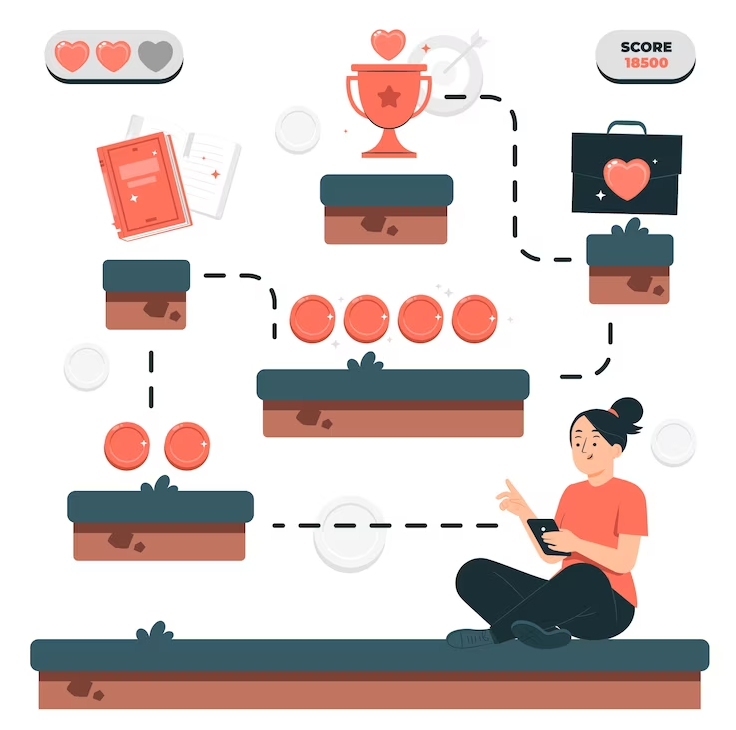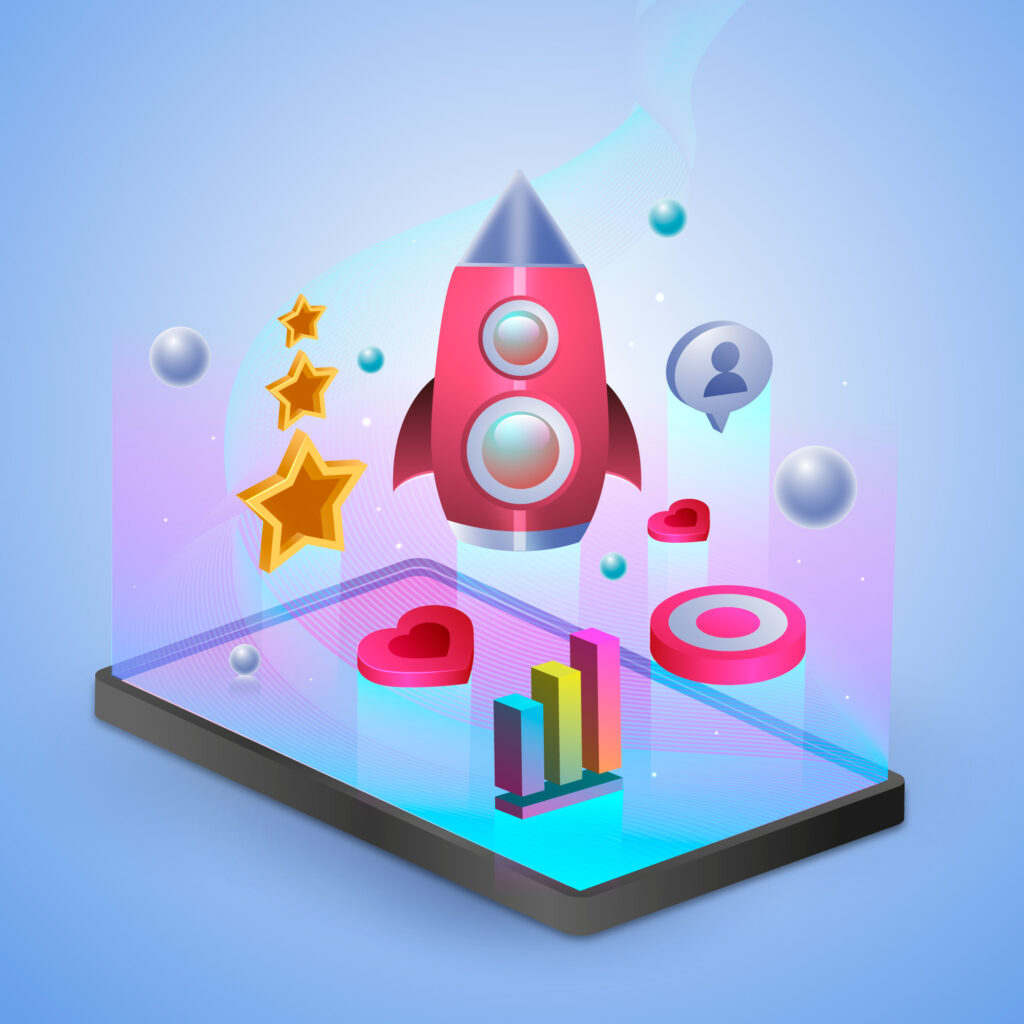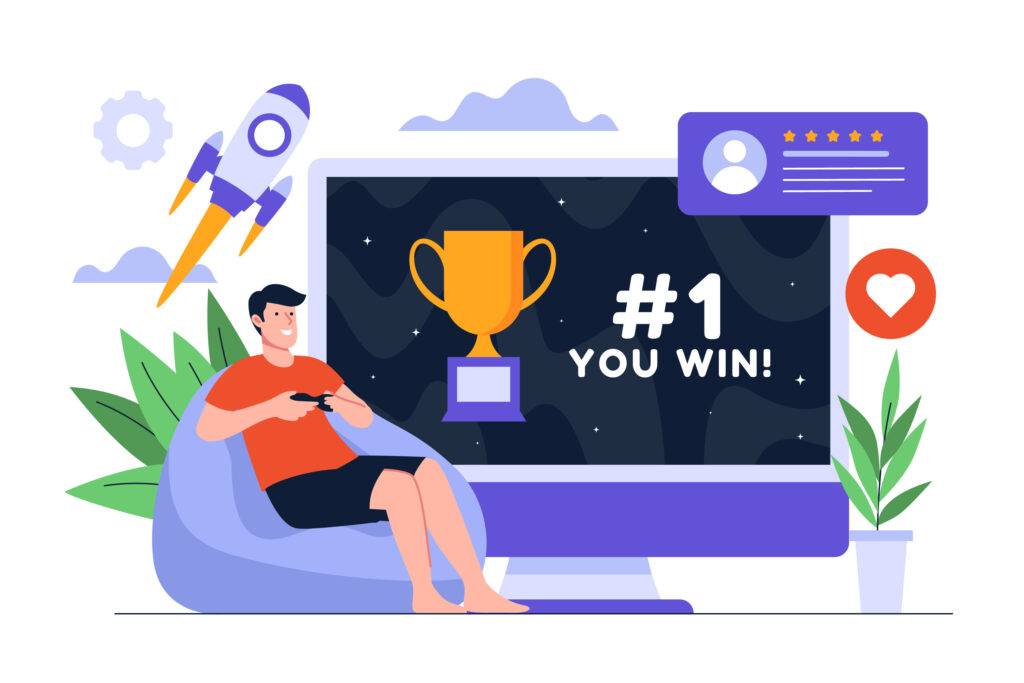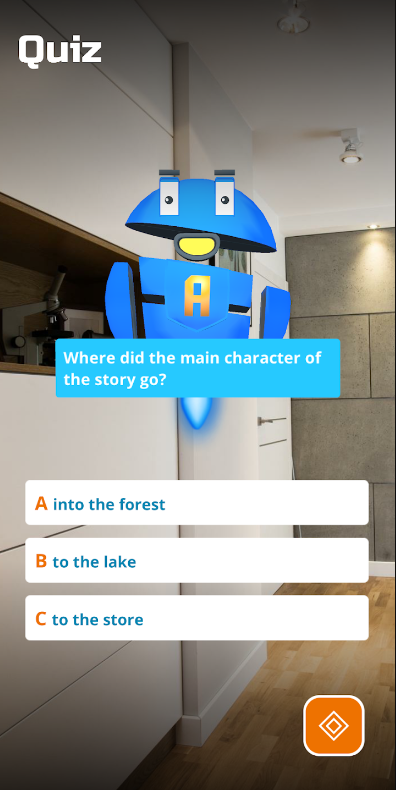In the fast-paced world of digital technology, new trends are always on the horizon. In recent years, one popular strategy called gamification has been gaining traction as a powerful tool for engagement, learning, and behavior change. But is gamification effective? Are we simply playing games, or is there more to this strategy than meets the eye?
This article dives deep into the world of gamification, exploring its various facets, from its application in education to its use in marketing and beyond.
We’ll look at real-world examples and studies to determine whether gamification delivers on its promises or if it’s just another industry buzzword. So, gear up for an exciting journey into the realm of gamification.
Read on to discover the effectiveness of gamification throughout different industries and domains!
Key Takeaways
- Gamification is a powerful tool that uses elements from video games to encourage engagement, motivation, and learning. It’s effective in various areas like education, healthcare, business, and marketing.
- Gamification can significantly improve performance. A study found that challenge-based gamification improved student performance by up to 89.45% compared to traditional lecture-based education.
- Gamified learning improves memory and recall rates. Research shows that students can retain as much as 90% of information learned through interactive activities.
- Gamified learning boosts motivation. A study showed that over two-thirds of students felt more motivated when using gamified learning compared to traditional courses.
- Gamification enhances task completion and understanding rates. Students using a gamified system completed tasks faster and had improved comprehension of the curriculum.
- The introduction of gamification into medical education has shown promising results, with increased learner engagement and a clear preference over traditional teaching methods.

Why Is Gamification So Popular?
Gamification has seen a meteoric rise in popularity due to its unique ability to make mundane tasks enjoyable while promoting engagement and motivation.
This strategy utilizes elements from video games, such as scores, levels, challenges, and rewards, to motivate individuals and encourage desired behaviors. The appeal of gamification lies in its versatile nature – it can be applied across a multitude of domains, from education and healthcare to business and marketing.
In the classroom, gamification can transform traditional learning into an interactive experience. Students are more likely to stay engaged when they are actively participating in their learning process.
For instance, educational apps employ gamification techniques to improve students’ understanding of complex subjects through fun quizzes and interactive lessons.
In the business sphere, gamification is used to improve employee performance and morale. Companies use games to foster competition among employees, encouraging them to achieve their goals while having fun at the same time.
Gamification also serves as an effective tool for customer engagement in marketing strategies. Businesses can leverage game-like features in their products or services to attract and retain customers.
All these examples illustrate why gamification is a sought-after strategy in various sectors. And the best thing is – imperial evidence supports its effectiveness.
Gamification Improves Performance
Imagine the thrill of boosting your performance by nearly 90% just by embracing a challenge-based, interactive approach to learning! This isn’t just a leap of faith or an over-hyped promise. It’s scientifically proven that gamified learning can remarkably enhance your learning outcomes.
A 2020 study conducted at the National Technical University of Athens found that students who used a web-based gamified application called ‘Horses for Courses’ saw an astounding increase in their performance.
Here are four key takeaways from this groundbreaking study:
- Challenge-based gamification improved student performance by up to 89.45% compared to more traditional lecture-based education.
- The overall performance of students increased by 34.75%, demonstrating the broad effectiveness of the gamification strategy.
- The research involved 365 students, thus providing a substantial sample size and enhancing the reliability of the findings.
- The experiment focused on statistics, a subject often considered difficult and unengaging, yet it still yielded exceptional results.
The study makes it clear that gamification is not just a passing fad but a significant and impactful approach that can elevate learning outcomes in a substantial way.
Gamification Benefits Memory and Recall
You’re in a lecture, straining to remember every word that’s said, but it’s like trying to catch water with your bare hands – evasive and slippery. Now picture this: instead of merely listening, you’re actively engaging with the information through games and challenges.
Suddenly, your retention soars to new and exciting heights. It’s not magic; it’s simply the power of active learning unlocked by gamified education.
This leap in retention rates is backed by research conducted by the Federation of American Scientists.
Their 2006 study found that students who passively listened to a lecture could only recall about 20% of what was shared. Visuals could bump up retention slightly to 30%. However, when students were engaged in action alongside explanation – an integral part of gamified learning – their memory and recall rose significantly to 50%.
The real game-changer? If the same students got a chance to perform tasks themselves using gamification techniques, they could retain as much as 90% of what they learned.
This suggests a clear correlation between interactive learning methods utilized in gamification and improved memory retention. In simple terms: when we learn by doing something, we remember more.
This has profound implications for educators seeking effective ways to improve student performance and engagement levels. So next time you’re faced with a complex topic or struggling with memorization, consider exploring gamified solutions as part of your learning approach – you’re bound to see great improvement in all areas!
Gamification Has a Positive Impact on User Engagement
Upon introducing a system of virtual badges as rewards for completing specific training activities, the Online Travel Training platform observed a significant surge in user engagement.
It was recorded that there was an average increase of 65% in user engagement, with certain users exhibiting a three-fold rise in online activity. This substantial shift implies the effectiveness of gamification strategies in fostering higher levels of participation and interaction among users.
The notable increase can be attributed to several factors related to gamification:
- The use of virtual badges leverages the human psychological inclination towards achievement and competition.
- The explicit objectives defined by these training activities provide clear targets for users to aim for, thus motivating their continued participation.
- Gamification can create an immersive learning environment that sustains interest and prevents attrition.
- Virtual rewards provide instant gratification, which further encourages consistent engagement.
This trend suggests that gamification could serve as an effective tool within digital platforms to boost user engagement. The intrinsic motivation triggered by game elements such as points, badges, or leaderboards can potentially stimulate more frequent usage and deeper involvement in site activities.
Moreover, the competitive aspects embedded within gamified environments might also contribute to increased rates of return visits and extended durations on the platform.

Gamification Boosts Motivation
Think about the last time you were truly excited to learn something new – doesn’t it feel like ages ago? Gamification could be your answer to rekindling that spark, to feeling that thrill of discovery again. It’s not just a buzzword – it’s a powerful and effective learning tool.
A 2018 study conducted among 124 students revealed that over two-thirds (67.7%) felt more motivated when using gamified learning compared to traditional courses.
Even more interestingly, the demographics of the participants didn’t seem to influence the results. Regardless of their age, gender, or student status, the majority of participants reported a higher motivation level when their learning experience included gamification elements.
Gamification Augments Training Routines
The great strength of gamification is its ability to make boring tasks feel less like a chore. This is particularly evident when it comes to using gamified techniques in employee training environments.
Have you ever sat through a dull training session? The 2019 Gamification at Work survey conducted by the TalentLMS indicates that nearly half of those who receive non-gamified training find it uninteresting and even unproductive.
The figures are quite stark – 49% found the lessons boring, and 12% considered the training as wasted time. These are far from ideal conditions for effective learning or skill development.
However, introducing elements of gamification into such scenarios could dramatically turn things around. Incorporating game mechanics like point systems or competition with others has been shown to make the process significantly more appealing.
A remarkable 83% of individuals reported feeling motivated when their training included the elements of playfulness and challenge, while only 13% reported commenting negatively on it. That’s an impressive swing towards better training outcomes just by adding some game-like aspects into the mix!
Gamification Raises Homework Completion Rates
Imagine the satisfaction of checking off all your assignments well before the deadline – it sounds like a dream, right? Once you start implementing gamification elements, it’s far more attainable than you might think!
One 2017 study involved computer science students in an effort to gauge the effectiveness of gamification. The results were astonishing – those who were partaking in a course that was spruced up with leaderboards, badges, and titles saw their homework completion rate soar to an impressive 56.25%. This is compared to just 18.5% for those in a traditional setup.
Consider these interesting facts:
- The gamified course kept students engaged and motivated to complete their tasks.
- Leaderboards inspired friendly competition among peers, pushing them to do better.
- Badges served as visual reminders of progress made and milestones achieved.
- Titles gave students tangible goals to strive for.
- All these elements combined transformed mundane homework into an engaging challenge.
A 304% increase in homework completion is an unprecedented outcome that clearly portrays the power of gamification as an effective motivator and engagement tool.
If tasks as boring as homework can be transformed into fun activities through gamification, imagine the possibilities it holds for other realms of life!
Gamification Enhances Task Completion
Just like a skilled archer swiftly hitting the bullseye, you too could complete your tasks at lightning speed once learning is transformed into an interactive game.
An evaluation of two tutorial systems – one gamified and the other traditional – revealed that learners using a gamified system not only felt highly engaged but also completed tasks significantly faster.
The survey showed that students were able to complete 10% more testing tasks and managed to finish those tasks up to 76% faster than their counterparts who used a non-gamified tutorial.
Gamification Impacts Curriculum Understanding Rates
The introduction of playful and interactive elements in education has significantly bolstered students’ comprehension of their curriculum.
A 2021 study involving 260 management students underscores this perspective. The implementation of gamification solutions throughout the semester led to a remarkable outcome.
As many as 75.5% of these students reported an improvement in their understanding of the curriculum, showing that gamified learning can be a potent tool for enhancing academic knowledge and skills.
Analyzing this pedagogical approach further, it’s clear that gamification encourages creativity among learners – a crucial factor in comprehensive learning. This was evident when 85% of students involved in the study expressed their delight at having an opportunity to be creative within their coursework.
It’s likely that this increased level of creativity positively impacted their understanding and retention of course material.
The impact doesn’t stop at just improved understanding and creativity – there’s also a clear desire among learners for more widespread use of gamification across other subjects.
An impressive 89% voiced their preference for similar gamified experiences to be introduced into other subject areas, demonstrating not only the effectiveness but also the popularity of such an approach among modern-day learners.
So while traditional lecture-based education still holds its place, it becomes clear that incorporating gaming elements into teaching strategies can offer substantial benefits in boosting student engagement and comprehension levels across various disciplines.
Gamification Boosts Medical Student Engagement
Medical studies are among the most demanding and rigorous fields of science. The complexity and volume of information that needs to be memorized can often overwhelm students, leading to disengagement and burnout. However, the introduction of gamification into medical education has shown promising results.
In one such 2020 study conducted among obstetrics and gynecology residents, learners were divided into small groups and tasked to complete various challenges within a gamified model.
The results were clear as day – an overwhelming 95% reported feeling engaged during the gamified session.
The effectiveness of this pedagogical approach goes beyond just keeping learners interested.
Analyzing the data further reveals that not only are learners more engaged with gamified models, but they also find them better than traditional lectures. Around 74% agreed that the activity was superior to conventional teaching methods.
This is significant as traditional lectures often leave students feeling disengaged and uninterested in their studies.

Aribo Can Help You Gamify Your Learning Process
The proven effectiveness of gamification can be a blessing, particularly given how low the engagement rates tend to be in traditional learning settings. The question is, how do you implement game mechanics into your routine to combat this issue?
This is where Aribo comes in. Aribo is an innovative platform that makes learning fun and engaging by incorporating gamification elements into different routines.
Aribo leverages the principles of game design to improve user engagement, retention, and overall learning experience. It uses a variety of game elements such as badges, leaderboards, points, and quests to create a motivating and rewarding learning environment.
The platform is designed with flexibility in mind, accommodating different learning styles and paces. Whether you’re a visual learner who enjoys interactive graphics or a competitive individual who thrives on leaderboards, Aribo has something for everyone.
Choose a subscription plan today and game your way to success with Aribo!

source: https://play.google.com/store/apps/details?id=pl.widelane.dev.aribo&hl=pl&gl=US
Conclusion
The effectiveness of gamification is undeniable. It has been proven to increase engagement, boost motivation, enhance understanding and retention, and improve overall performance across various industries and domains.
Its versatility and adaptability make it a practical tool for both educators and learners alike.
Despite its relatively recent emergence, gamification has already shown great potential in revolutionizing traditional learning methods.
Its ability to transform mundane tasks into engaging challenges is undeniably its greatest strength.
But as with any tool, the key lies in how well it’s utilized. To maximize the benefits of gamification, it needs to be integrated thoughtfully and strategically into your learning approach or business model.
And this is where platforms like Aribo can help.
By incorporating game-like elements into your routine, Aribo can help you unlock the full potential of gamification.
So why wait? Embrace this innovative approach today and experience the transformative power of gamified learning first-hand! Good luck!

